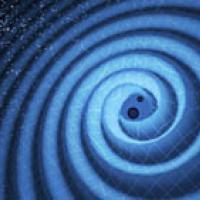
Stuff happens: Listening to the Universe
Gravitational waves: they are the echoes of the most calamitous events in the Universe, like the collisions of black holes, yet it has taken us nearly 100 years to finally be able to hear them. The detection of gravitational waves has been the end of a theoretical quest to confirm Einstein's predictions, and a technical quest to hear their tiny echoes when they finally meet our detectors. It has earned Rainer Weiss, Barry C. Barish and Kip S. Thorne the 2017 Nobel Prize in Physics. But this is also just the beginning of a new wave of gravitational astronomy, opening the possibility of deeper understanding of our Universe.
This collection of articles and videos tells you all you need to know about gravitational waves and their discovery. They are based on an interview with Gabriela Gonzáles, Professor of Physics at Louisiana State University and former spokesperson of the LIGO Scientific Collaboration, and a lecture given by Kip Thorne, a pioneer in all things gravitational waves. We also bring you a relevant article from the FQXi Community website.
These articles and videos are part of our Stuff happens: The physics of events project.
Articles
Listening for ripples in spacetime — This article describes the enormous effort that was made to detect gravitational waves and the excitement of their discovery.
New windows on the Universe — Find out what gravitational waves will tell us about the Universe: from understanding its birth to figuring out whether black holes have hairs.
You might want to read these short articles for some background:
Maths in a minute: Einstein's theory of general relativity — It was Einstein who first predicted that gravitational waves should exist, based on his general theory of relativity. Find out more here.
Maths in a minute: Black holes — Here's a quick introduction to the monsters that lurk at the centre of each galaxy, and whose collisions cause gravitational waves.
Maths in a minute: Gravitational waves — And here's a quick introduction to the spacetime ripples themselves. What are they and where do they come from?
Maths in a minute: How does laser interferometry work? — This is a brief explanation of how gravitational wave detectors like LIGO go about their business.
This article first appeared on the FQXi Communities website.
Dropping Schrödinger's cat into a black hole — Since the detection of gravitational waves we know for sure that black holes do exist. To understand what really goes on inside them we need a new theory.
Videos
Gabriela González, Professor of Physics and Astronomy at Louisiana State University and former Spokesperson of the LIGO Scientific Collaboration, talks about gravitational waves and their discovery.
This is a video of Nobel laureate Kip Thorne, pioneer in gravitational wave theory, giving the 2017 Andrew Chamblin Memorial Lecture at the University of Cambridge.
Pau Figueras, former Stephen Hawking advanced postdoctoral research fellow at the University of Cambridge, explains black holes.